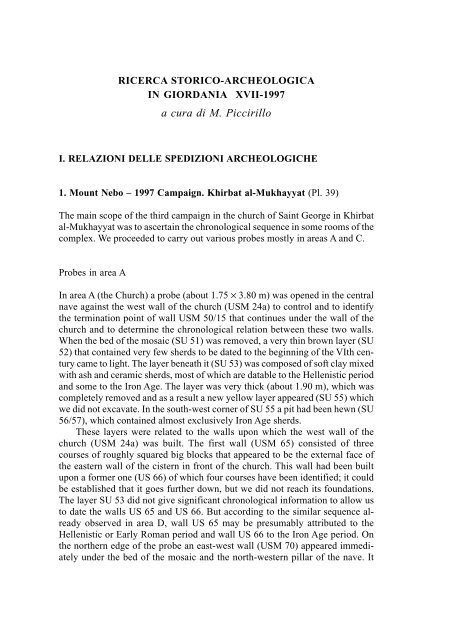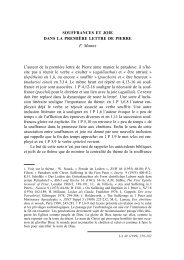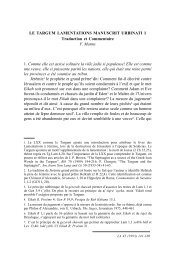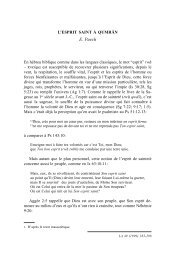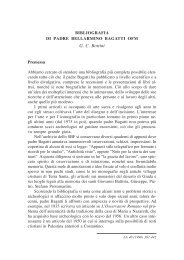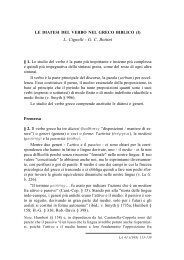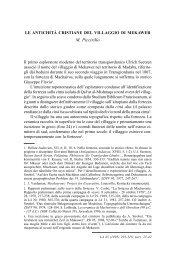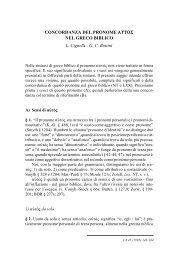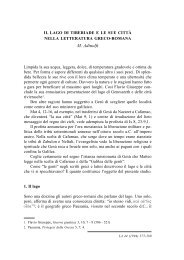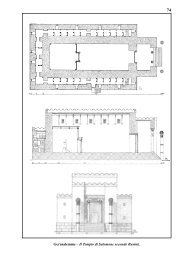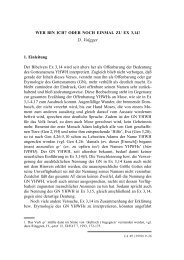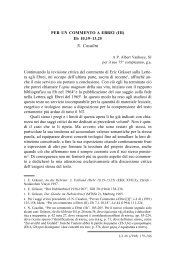Ricerca storico-archeologica in Giordania XVII – 1997
Ricerca storico-archeologica in Giordania XVII – 1997
Ricerca storico-archeologica in Giordania XVII – 1997
Create successful ePaper yourself
Turn your PDF publications into a flip-book with our unique Google optimized e-Paper software.
RICERCA STORICO-ARCHEOLOGICA<br />
IN GIORDANIA <strong>XVII</strong>-<strong>1997</strong><br />
a cura di M. Piccirillo<br />
I. RELAZIONI DELLE SPEDIZIONI ARCHEOLOGICHE<br />
1. Mount Nebo <strong>–</strong> <strong>1997</strong> Campaign. Khirbat al-Mukhayyat (Pl. 39)<br />
The ma<strong>in</strong> scope of the third campaign <strong>in</strong> the church of Sa<strong>in</strong>t George <strong>in</strong> Khirbat<br />
al-Mukhayyat was to ascerta<strong>in</strong> the chronological sequence <strong>in</strong> some rooms of the<br />
complex. We proceeded to carry out various probes mostly <strong>in</strong> areas A and C.<br />
Probes <strong>in</strong> area A<br />
In area A (the Church) a probe (about 1.75 × 3.80 m) was opened <strong>in</strong> the central<br />
nave aga<strong>in</strong>st the west wall of the church (USM 24a) to control and to identify<br />
the term<strong>in</strong>ation po<strong>in</strong>t of wall USM 50/15 that cont<strong>in</strong>ues under the wall of the<br />
church and to determ<strong>in</strong>e the chronological relation between these two walls.<br />
When the bed of the mosaic (SU 51) was removed, a very th<strong>in</strong> brown layer (SU<br />
52) that conta<strong>in</strong>ed very few sherds to be dated to the beg<strong>in</strong>n<strong>in</strong>g of the VIth century<br />
came to light. The layer beneath it (SU 53) was composed of soft clay mixed<br />
with ash and ceramic sherds, most of which are datable to the Hellenistic period<br />
and some to the Iron Age. The layer was very thick (about 1.90 m), which was<br />
completely removed and as a result a new yellow layer appeared (SU 55) which<br />
we did not excavate. In the south-west corner of SU 55 a pit had been hewn (SU<br />
56/57), which conta<strong>in</strong>ed almost exclusively Iron Age sherds.<br />
These layers were related to the walls upon which the west wall of the<br />
church (USM 24a) was built. The first wall (USM 65) consisted of three<br />
courses of roughly squared big blocks that appeared to be the external face of<br />
the eastern wall of the cistern <strong>in</strong> front of the church. This wall had been built<br />
upon a former one (US 66) of which four courses have been identified; it could<br />
be established that it goes further down, but we did not reach its foundations.<br />
The layer SU 53 did not give significant chronological <strong>in</strong>formation to allow us<br />
to date the walls US 65 and US 66. But accord<strong>in</strong>g to the similar sequence already<br />
observed <strong>in</strong> area D, wall US 65 may be presumably attributed to the<br />
Hellenistic or Early Roman period and wall US 66 to the Iron Age period. On<br />
the northern edge of the probe an east-west wall (USM 70) appeared immediately<br />
under the bed of the mosaic and the north-western pillar of the nave. It


